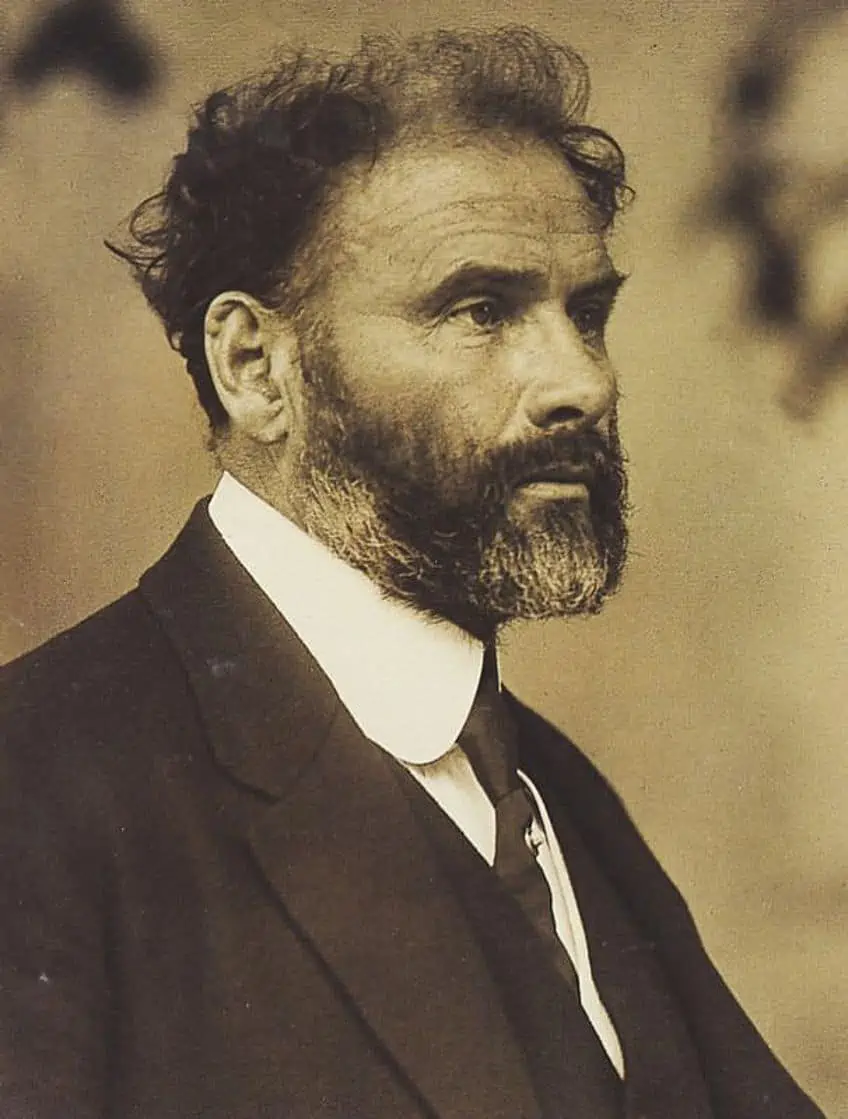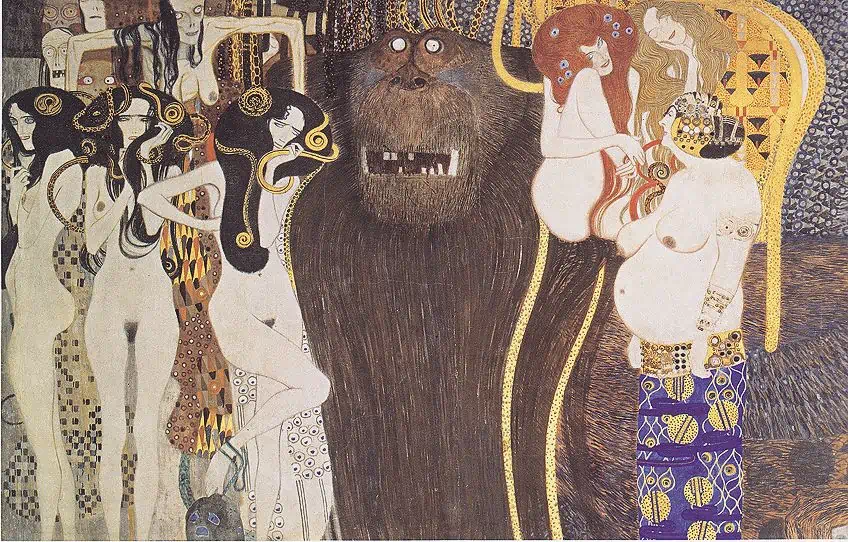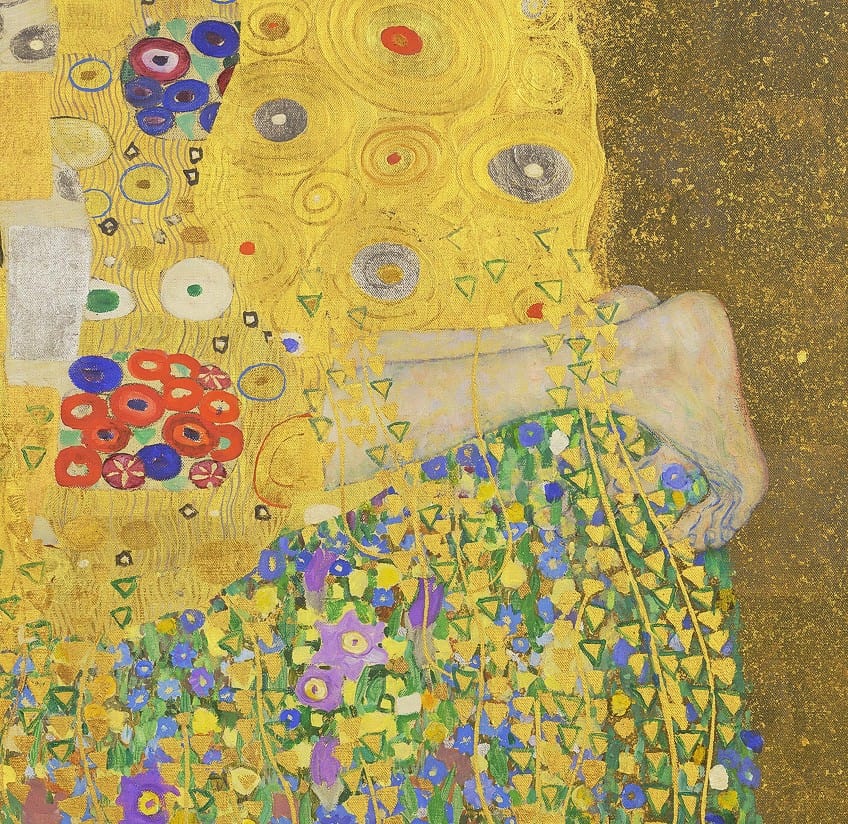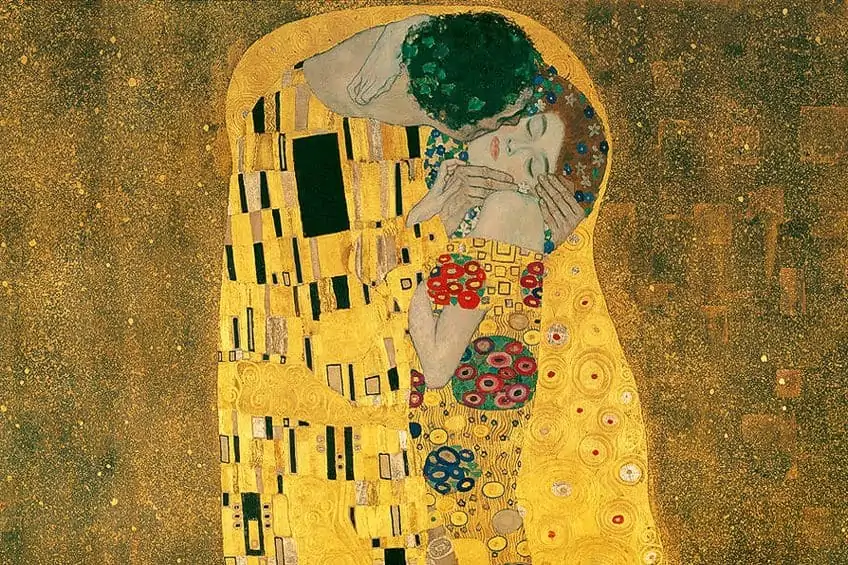“The Kiss” by Gustav Klimt – An Analysis of the Famous Painting
The Kiss by Gustav Klimt is the most famous work by this Viennese artist. Years after its creation art enthusiasts still flock to see the two embracing lovers depicted in the typical golden Klimt style. There is something so tender and touching about this masterpiece, but what is it exactly that led to the success of this impressive work? In this article, we will perform a brief discussion of The Kiss’ painter, Gustav Klimt, do an in-depth analysis of The Kiss painting, and will look at some interesting facts, answering questions like, “Where is The Kiss painting housed?” This is all to understand why The Kiss painting has had such a profound impact on the world of art.
The Kiss Painter: An Artist Abstract of Gustav Klimt
| Date of Birth | 14 July 1862 |
| Date of Death | 6 February 1918 |
| Country of Birth | Baumgarten, Austrian Empire |
| Associated Art Movements | Symbolism, Art Nouveau, Vienna Secession movement |
| Art Style | Decorative style of painting |
| Mediums Used | Painting, drawing, objets d’art |
| Dominant Themes | Eroticism, women, and the “femme fatale” |
The Kiss painter, Gustav Klimt was born on July 14, 1862, in Vienna, Austria, and died on February 6, 1918, in Vienna. His father was a poor Bohemian gold engraver and his mother had musical talent that she never pursued further. As he showed talent in the arts from a young age, Gustav Klimt received a full scholarship to leave his normal school at the age of 14 to attend the Vienna School of Arts and Crafts.
His talent earned him many commissions and led to the opening of a successful studio in 1883 after he completed his studies.

In the early years of his career, Klimt painted in the traditional style popular amongst the Viennese upper class. He focused on murals and got many more commissions from wealthy families. He shared this success with his brother, Ernst, who was part of his studio group. When his brother and father died in the same year (1892), it altered Klimt’s entire life and art practice. He moved away from the accepted naturalistic style he was trained in and started developing a personal style.
He founded the Vienna Secession group with a bunch of other artists and started focusing on supporting and developing non-traditional Austrian art.
Klimt’s work started becoming more provocative with erotic themes causing scandal wherever he went. The themes he painted reflected his promiscuous life from which he acknowledged three illegitimate children, although it is rumored that he had 14 more. Besides the erotic themes of his work, Klimt was also preoccupied with death. Despite the controversy around his new painting style, Klimt was still achieving great success with his work – most famously so with his golden phase.
The Kiss (1907 – 1908) by Gustav Klimt in Context
| Artist | Gustav Klimt |
| Date Painted | 1907 – 1908 |
| Medium | Oil and gold leaf on canvas |
| Type of Painting | Figure painting |
| Dimensions | 180 x 180 cm |
| Series / Versions | N/A |
| Location | Österreichische Galerie Belvedere, Vienna, Austria |
| Price | The Austrian government paid Klimt $240,00 for The Kiss before it was finished. It has not been up for auction since. |
Turn-of-the-century Vienna was marked by a great inconsistency in political and societal values with socialism, individualism, and other similarly contradicting opinions being promoted at the same time. Klimt working as an artist at this time did not challenge this inconsistency but instead embodied it. His works are known for their multiplicity, having both the naturalistic and mannered both inherent in them. The question surrounding his works is: Was he analyzing life or escaping it through painting? Is it the real or the fantastical he is depicting?
Gustav Klimt was one of the key figures in the art scene in Vienna during the 1900s. One reason Klimt reached so much fame in his life was that he demonstrated extreme talent in capturing the multiplicity of the culture in Vienna at the time.

His work is soaked through with the contradictions, hybridization, and mix of cultures of his time. The other reason is that he was a male painter and privilege to have a life free from many moral restraints. 95 percent of Klimt’s work depicts the female figure. This illustrates the life of a young man in Vienna, left to take care of his affairs until he was deemed a “real” man by society (usually this was only around the age of 26). Klimt’s world was a world full of casual relationships with prostitutes, dancers, models, and hostesses.
Even his paintings that were commissioned by the Viennese upper class had elements of this dark life filled with naked bodies, opulence, and hedonism.
His reality of sexuality being for sale to those empowered by riches is what lies behind The Kiss and most of his sex-positive work. But the layered symbolism, allegory, and mythology present in this painting bring out the pathos and humanity of the act of lovemaking and, again, highlight the contradiction and multiplicity of Klimt’s work.
Contextual Analysis: A Brief Socio-Historical Overview of The Kiss by Gustav Klimt
Vienna, at the time of Klimt, was the celebrated center of a multi-nation state. Conservative writers and theorists (who inspired Hitler) were on the scene during Gustav Klimt’s practicing years as a painter. They were actively speaking against the opulent lifestyle by which many Viennese upper-class citizens were living. Rich individuals inherited their family fortunes without having to lift a finger for it. They spent it on lavish lifestyles, with Klimt finding many of his patrons in this group of people.
This clash between conservative and liberal values only stayed peaceful thanks to the monarchal rule by the emperor, Franz Josef.
The particular social environment of the city also added to this hotbed of opinions co-existing, as eccentric figures such as Klimt himself held together a strong appreciation for culture, celebrated in theaters, operas, public art, and exhibitions. This undercurrent of cultural appreciation translated into a proud identification with being Austrian.

Artists were searching for a uniquely Austrian kind of art and this ploy was another very important element in keeping the contradicting views coexisting peacefully (for a time) in Vienna. Klimt and a group of other artists withdrew from formal art institutions to practice independently (furthering the quality of inconsistency present in the city). They were rewarded and received well with their first exhibition in 1897 with Klimt as their president. The “Austrian kind of art” these artists were looking for, became integrated (maybe most successfully so) into Klimt’s work.
The combinations of decorative art, international styles of the time, as well as the representation of the “burden of refinement” are all overwhelmingly present in his work.
The snobbishness, elitism, and aestheticism mixed with the tangible and sensitive way he captured the women from the upper class, especially, shows the very real relationship he had with his models. This mix of class burdens and privileges with palpable humanness was Vienna in the 1900s and Klimt captured it and cemented it in an “Austrian” style of art that would become famous until well past his life.
Formal Analysis: A Compositional Overview
The Kiss by Gustav Klimt was created at the height of the painter’s most successful period, the “Golden Period”, and was purchased by the Austrian Government even before it was finished. In 1908, it was exhibited under the title, The Lovers.
In the painting, a couple is embracing each other at the end of a flowery meadow. The woman, crowned with a flower crown, is facing the viewer with her eyes closed.

With one arm wrapping around the man’s neck and her other hand resting gently on his hand, which is cradling her face, she is savoring the kiss he is planting on her turned cheek. The man’s face is not shown and his head is crowned with a crown of vines. The woman’s feet are exposed and the couple is nearly indistinguishable from the background of patterns and swirling marks- their clothes are lavishly patterned as well. The woman is dressed in a flowing floral dress and the man is in a big patterned kaftan.
Let us do a formal analysis of the subject matter, color, pattern use, perspective, shape, symbols, and style of The Kiss painting.
Subject Matter
This massive painting (180 x 180 cm) depicts life-size lovers wrapped in gold robes, embracing each other. Both figures are painted in full, their entire bodies visible in the composition. Sexuality, love, and intimacy are popular themes of Klimt’s work and are at the center of this painting’s subject matter.
The Stoclet Frieze (1905 – 1911) and the Beethoven Frieze (1902) were created by Klimt before The Kiss and also show lovers in a similar embrace.
The couple in The Kiss is blended with the background as if they are getting lost in their love for each other. The intimacy of the moment is captured fully by the sensitivity of the woman’s face – adding further to the theme of love that seems so strong it can dissolve them altogether. The repeated patterns used in the background and robes almost abstract the image and destabilizes the naturalism of the woman’s face. This use of symbolism above naturalism indicates the unconscious mind, specifically its erotic urge and the reaching of a climax.
Even though the figures are fully clothed in heavy garments, Klimt successfully captured the moment of intense sensual pleasure. Even though Klimt is often described as a closed-off and ruminative man, his paintings had a way to speak for him. He famously said that if anyone wanted to know him and his desires, they simply had to look at his paintings.
This statement affirms the yearning present in the artist for this kind of undying love – a yearning that is almost palpable in The Kiss painting.
The message of The Kiss is expressive of a mysterious subconscious mind. It is no surprise that the work of Gustav Klimt is often linked to Sigmund Freud (Klimt’s compatriot and almost contemporary). The Kiss oozes sexuality and after his premature death at 55, more highly sexual works were found in Klimt’s studio, affirming the erotic undercurrent of his work.
Color, Pattern, and Form
More than the subject matter, it is Klimt’s use of bold colors, shapes, and patterns that make The Kiss painting still so impactful in the contemporary art world. Four years before the painting of The Kiss, Klimt traveled to Ravenna twice. The influence of Byzantine sacred art evident in this city bled into Klimt’s paintings.
These works later became known as part of his “Golden Period”, characterized by the lavish use of gold leaf, as seen in The Kiss as well.
The Kiss was one of the last paintings of Klimt’s Golden Period and culminated all of the elements in this style he developed during the last phases of his career. The use of gold also references Klimt’s earlier years living with his gold-carver father and the metalwork of his brother, Ernst, as well as the gold trimmings of religious art from the Middle Ages.

The Byzantine influence goes further in this painting and others like it, by signifying a move toward stability. In the use of static forms and inorganic shapes, the artist finds a haven after he explored the intuitive powers of ancient Greek art.
Similar to many of the artists that were part of the Vienna Secession, Klimt’s style is extremely decorative. The main way that he achieved this was through the use of patterns – obvious in The Kiss.
Brightly colored blocks, circles, spirals, squares, and triangles were laboriously painted in repetition in this composition, emphasizing Klimt’s attention to detail and his obsession with depicting love. The two lovers’ contrasting patterned cloaks show elements of the Arts and Crafts movement of the era during which Klimt worked. The influence of his signature Art Nouveau style is also undeniable in the bold use of color, pattern, and form.
Perspective and Space
A flattened composition was created by Klimt, with the lovers melting into a background of patterns and shapes very similar to that on their clothing. The background is a conflicted swirl of two- and three-dimensionality, which further abstracts the idea of perspective. The flatness of this composition is further evidence of the influence the flat mosaic tiles in the Church of San Vitale in Ravenna had on him. It is also an indication of the mixed influence of European art present in Vienna at the time.
The Cubists were practicing parallel to Klimt and this abstraction of form and perspective could have been influenced by the popular styles of Pablo Picasso and Georges Braque.
The flatness of the composition also reminds us of the influence of Japanese prints on earlier Impressionist paintings. This influence made its way through Europe and inspired artists like Klimt to use bold flat areas of paint. Besides the flatness of the composition and perspective, the painting is also cropped in a modern style, with the man’s head ending very close to the top of the painting.
This further confirms the influence of Japanese art on Klimt’s work. The naturalistic depiction of the faces, hands, feet, and arms of the lovers is in contrast to the simplified forms of their clothing and the background. This makes it clear that they are figures that stand apart from the background, but not much else is used by Klimt to indicate perspective or the space where they are embracing.
He, therefore, used the merging of the figures with the background in a flat plane to further drive home the subject of the painting: drowning love and desire.
Symbolism and Style
The Kiss as well as The Beethoven Frieze (1902) and The Tree of Life (1905 – 1911), form part of a symbolic study Klimt conducted during his Golden period. The Kiss is the climax of this study the allegory of the transcendental union of erotic and spiritual love. In these paintings, Klimt uses various symbols to depict the merging of the individual with the eternal universe.
The use of symbolism was his attempt to slightly veil the more shocking themes of his work, as well as the challenging psychological underpinnings of his art.
The Masculine and the Feminine
It was not common for Klimt to use a male and female form together in a painting and The Kiss is, therefore, a special painting of a select few. He used the male and female forms together to emphasize the dissolving nature of love so that what is individual becomes cosmic.
The male form is made dominant by the impressive coat decorated with masculine designs of gray and black blocks.

The masculinity of the patterns affirms a different energy than that of the female figure. The feminine form is contrasted against the male figure with the organic, feminine spirals and brightly painted floral patterns. These contrasting symbolic patterns are all that distinguish the two figures from each other. These distinctive patterns could also be suggestive of the male and female sexual organs.
The rectangles on the man’s cloak are erect and could suggest phallic shapes, while the woman’s dress is covered with circles that spiral inwards to a red, receptive center.
Fertility
From the sky it looks like golden rain is blessing the Earth, symbolizing fertility. This theme of fertility is echoed in the lush meadow the embracing couple is kneeling in. Water is further indicated by Klimt in the painting of triangular fronds that drape over the woman’s feet.
This use of triangular symbols as water is also done in another painting by the artist, called Water Serpents (1904 – 1907).
The Color Gold
The turn of the century in Vienna was marked by opulent and luxurious imagery. This is echoed in The Kiss. The use of gold should not be missed as also symbolic in meaning. Even though, as mentioned above, many influences led Klimt to use gold leaf in his paintings, the bright rich quality of this medium is also symbolic of the spirit of the time the painting was created in.
The gold he used so often during this phase of his career was previously only used in religious art.

This fact added to the shocking reception of Klimt’s golden paintings, as many of the Viennese conservative population thought them to be blasphemous. Klimt, however, uses gold as a symbol of the sacredness of love and sexual union. The use of gold makes these lovers timeless, almost immortal. They become modern icons, transcending normal life to become eternal symbols of the power of love. If we look at the rest of Klimt’s subject matter, it becomes clear that he thought humankind to be lost in an endless cycle of life and death.
This painting of the couple expresses the place he finds solace and meaning for our species: love.
Vitality
The aliveness and energy generated by the couple’s love and desire are symbolized in the swirling patterns and gold and silver leaf application. The painting is full of energy that is symbolic of the life force generated by the kind of eternal and cosmic love Klimt was obsessed with.
The Impact: The Eternal Kiss
So, now we can wonder why this painting of two lovers in a sensual embrace became such an influential artwork. To understand this, we must remember that what is shocking today is far removed from what was shocking in post-Victorian society.
Shocking Sexuality
In the early 1900s, the Viennese audience saw The Kiss as pornographic. Besides the fact that the couple is fully clothed, this level of sensual intimacy was not commonly depicted in art at the time. The emotion and sexuality that saturates the painting were deeply shocking and seen as something private that should be hidden from the public eye, not displayed and celebrated openly in a life-size, brightly painted artwork.
That being said, the Austrian government recognized that Klimt was on to something – that he was one of the first painters to successfully integrate the mix of cultures and influences in Vienna to create a uniquely Austrian style.
Despite the public’s outrage towards the shocking theme of The Kiss, it sold even before it was finished. The Belvedere Museum of Vienna, Austria, bought it for the price of 25,000 crowns – today roughly $240,000. This price was five times the amount ever paid before for any painting in Vienna.
Because of this open government investment in a painting that depicted such a shocking subject matter, The Kiss sparked more art that dealt directly with the theme of eroticism. It gave artists like Egon Schille (1890 – 1918) and Oskar Kokoschka (1886 – 1980) permission to openly address sexuality in their work. The Kiss, therefore, catalyzed a sexual revolution in the world of art.
This, along with the work of many more artists, led us to the contemporary place in the art world where also nothing is shocking because everything that was shocking was explored through art already.
Breaking Boundaries
Typical of 20th-century avant-garde art Klimt was breaking down the final boundaries around what was deemed acceptable and not acceptable as art. By defying the art academies of the time Klimt created ground-breaking art that influenced artists to become beyond just exploring shocking subject matters. With his bold use of color, pattern, and symbols, and by mixing all the different art styles around him, he forged a new path of visual expression for Modern and Post-Modern artists.
He was breaking down the barriers between art and life and life and design.
Yearning for Undying Love
A common theme Hollywood exploited and that has now become part of Western society is the fixation on romantic love. Besides the economic impact of the nuclear family, the Christian church and other conservative forces have created the ideal that only through monogamous love and professional success we can find fulfillment.
That being said, our society is more disconnected than ever before with the common use of social media, political polarization, and the isolation of a global pandemic adding fuel to our loneliness fires. In this world of yearning for connection and the idealization of monogamous love, the image of The Kiss could nothing but become one of the most reproduced paintings in the world.
The impressive, luminous painting of life-sized sweethearts oozing love and desire with the simple gesture of a kiss has impacted the world far past the artist, Gustav Klimt’s, initial intentions. This broody artist could not create in the restricted way of the art academy of 20th-century Vienna after his life was struck by tragedy and loss. In an attempt to forge his own path and create a unique national style, he created art that still moves the contemporary world. This completely new and vibrant style is embodied in the artist’s famous painting, The Kiss (1907 – 1908).
Take a look at our The Kiss painting webstory here!
Frequently Asked Questions
Who Painted The Kiss Painting?
The Kiss’ painter was the Viennese artist, Gustav Klimt, who created the artwork between 1907 and 1908. He was born on July 14, 1862, in Vienna, Austria, and died on February 6, 1918, in Vienna. He worked his entire life in Vienna, except for traveling to do artistic research throughout his career.
Where Was The Kiss Painted?
The Kiss (1907 – 1908) was painted in Gustav Klimt’s studio on the ground floor of 21 Josefstädterstraße in Vienna’s eighth district. His studio was a free-standing building in the backyard of a tenement building. His studio had access to a garden.
Where Is The Kiss Painting Housed?
The Kiss (1907 – 1908) is located at the Österreichische Galerie Belvedere Museum in Belvedere, Vienna. It hangs in the museum where it is yearly visited by thousands of art lovers. It is seen as one of the masterpieces to come out of the group, the Vienna Secession, and Klimt’s most popular painting.
Nicolene Burger, a South African multimedia artist and creative consultant, specializes in oil painting and performance art. She earned her BA in Visual Arts from Stellenbosch University in 2017. Nicolene’s artistic journey includes exhibitions in South Korea, participation in the 2019 ICA Live Art Workshop, and solo exhibitions. She is currently pursuing a practice-based master’s degree in theater and performance. Nicolene focuses on fostering sustainable creative practices and offers coaching sessions for fellow artists, emphasizing the profound communicative power of art for healing and connection. Nicolene writes blog posts on art history for artfilemagazine with a focus on famous artists and contemporary art.
Learn more about Nicolene Burger and about us.
Cite this Article
Nicolene, Burger, ““The Kiss” by Gustav Klimt – An Analysis of the Famous Painting.” artfilemagazine – Your Online Art Source. November 9, 2022. URL: https://artfilemagazine.com/the-kiss-by-gustav-klimt/
Burger, N. (2022, 9 November). “The Kiss” by Gustav Klimt – An Analysis of the Famous Painting. artfilemagazine – Your Online Art Source. https://artfilemagazine.com/the-kiss-by-gustav-klimt/
Burger, Nicolene. ““The Kiss” by Gustav Klimt – An Analysis of the Famous Painting.” artfilemagazine – Your Online Art Source, November 9, 2022. https://artfilemagazine.com/the-kiss-by-gustav-klimt/.



